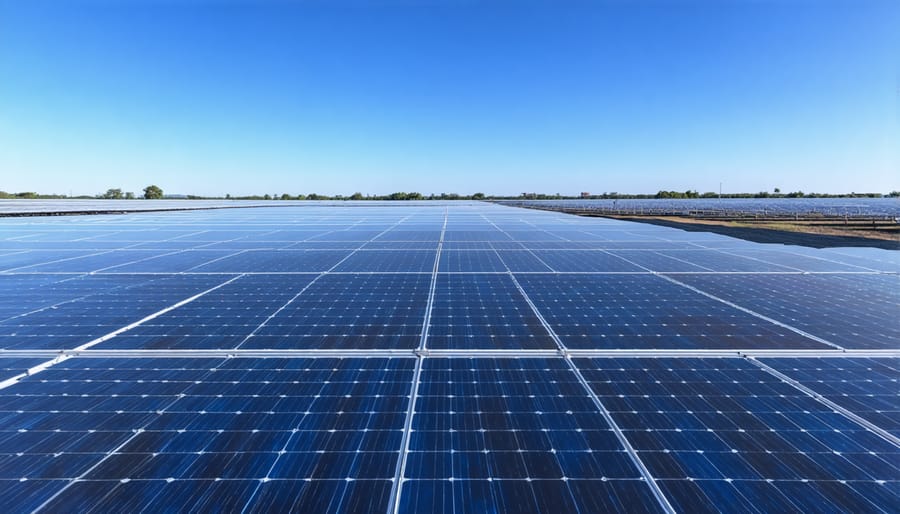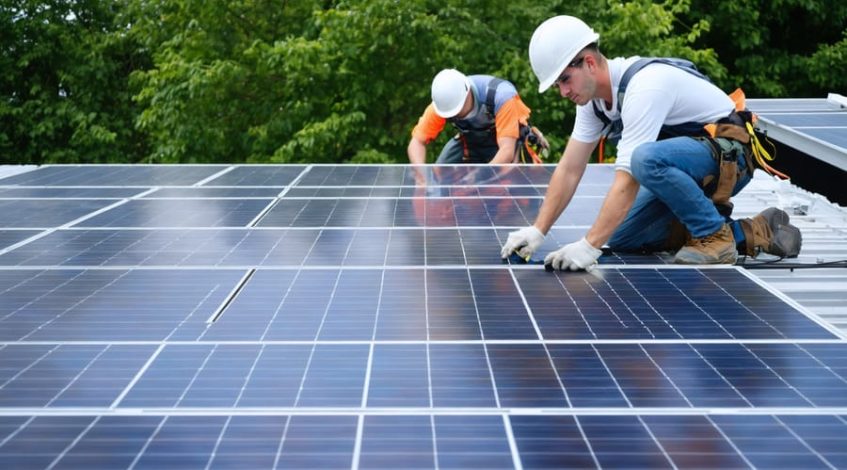The transition to renewable energy represents more than an environmental imperative—it’s becoming one of the most significant drivers of economic growth and job creation in the 21st century. With global investments in clean energy reaching $1.1 trillion in 2022, the sector is generating employment opportunities at nearly three times the rate of traditional industries. From solar panel installation specialists to wind turbine technicians, renewable energy is creating a new generation of skilled workers while revitalizing traditional manufacturing and construction sectors.
This transformation extends beyond direct employment in renewable technologies. Supply chain management, research and development, and energy efficiency consulting are emerging as robust career pathways. Studies indicate that renewable energy projects create an average of 7.49 full-time jobs per million dollars invested, compared to 2.65 jobs in fossil fuel projects. Furthermore, these positions often offer higher wages and better long-term stability than conventional energy sector roles.
As countries accelerate their commitments to carbon reduction targets, the renewable energy sector is positioned to become a cornerstone of economic recovery and sustainable growth. For businesses, communities, and workers, this shift presents unprecedented opportunities to participate in the clean energy economy while building resilient, future-proof careers.
The Growing Renewable Energy Sector
Market Growth Statistics
The renewable energy market growth has demonstrated remarkable momentum, with the global renewable energy sector reaching $1.5 trillion in 2022 and projected to exceed $2.8 trillion by 2030. Solar and wind energy installations have dominated this expansion, accounting for 75% of new power generation capacity worldwide in 2022.
Employment statistics reflect this substantial growth, with the renewable energy sector currently employing over 12.7 million people globally. The International Renewable Energy Agency (IRENA) forecasts this number to triple by 2030, reaching approximately 38 million jobs worldwide. Solar energy leads job creation, representing 4.3 million jobs, followed by bioenergy with 3.4 million and wind power with 1.4 million positions.
In developed markets, the industry is experiencing annual growth rates of 15-20%, while emerging economies are seeing even more dramatic increases, often exceeding 25% year-over-year. This expansion is driven by falling technology costs, with solar panel prices decreasing by 80% over the past decade and wind turbine efficiency improving by 40%, making renewable energy increasingly competitive with traditional power sources.
Investment Trends
Investment in renewable energy has reached unprecedented levels, with global commitments exceeding $500 billion in 2022. Private sector involvement continues to drive this growth, accounting for approximately 70% of total investments. This surge reflects a broader energy market transformation as businesses recognize both environmental and economic benefits.
Corporate investments are particularly notable in utility-scale solar and wind projects, with major tech companies leading the way through power purchase agreements (PPAs). Investment banks and institutional investors have also increased their renewable energy portfolios, citing stable returns and declining technology costs as key motivators.
Public sector funding remains crucial, with governments worldwide implementing green stimulus packages and dedicated renewable energy funds. These initiatives often combine direct investment with incentive programs, creating a multiplier effect that attracts additional private capital. Notable examples include the EU’s Green Deal Investment Plan and similar programs in Asia-Pacific economies.
The trend shows a clear shift toward sustainable infrastructure, with analysts projecting investment growth of 12-15% annually through 2030. This sustained funding pipeline ensures continued job creation and economic development across the renewable energy sector.
Job Creation Impact
Direct Employment Opportunities
The renewable energy sector generates substantial direct employment opportunities across various project phases, from initial development to ongoing operations and maintenance. Solar installation technicians, wind turbine specialists, and project managers represent some of the most in-demand positions in this growing field. These roles typically offer competitive salaries and long-term career stability, reflecting the sector’s sustained growth.
As urban renewable energy development continues to expand, construction and installation jobs have seen particularly strong growth. Solar panel installers, electrical technicians, and system designers are consistently ranked among the fastest-growing occupations, with demand expected to increase by 50-60% over the next decade.
Manufacturing positions in renewable energy equipment production facilities create additional employment opportunities. These roles include production line workers, quality control specialists, and engineering professionals who design and improve renewable energy technologies. The localization of manufacturing facilities often provides significant employment benefits to regional communities.
Operations and maintenance positions offer stable, long-term employment prospects. Wind farm technicians, solar maintenance specialists, and monitoring system operators ensure the efficient functioning of renewable energy installations. These roles typically require specialized training and certification, creating opportunities for skilled workforce development.
Project development and management positions represent another significant employment category. Environmental impact assessors, site surveyors, and project coordinators play crucial roles in bringing renewable energy projects from concept to completion. These positions often combine technical expertise with business acumen, offering attractive career paths for professionals seeking to contribute to the clean energy transition.

Indirect and Induced Employment
The economic impact of renewable energy extends far beyond direct employment, creating substantial ripple effects throughout local and regional economies. For every direct job created in the renewable energy sector, studies indicate that an additional 2.5 to 3.5 indirect and induced jobs are generated across various industries.
Indirect employment occurs in supply chain operations, with manufacturers producing components, logistics companies managing transportation, and service providers supporting renewable energy projects. These positions include roles in electrical equipment manufacturing, construction materials supply, professional services, and technical consulting.
The induced employment effect materializes as renewable energy workers spend their wages in local communities. This spending supports jobs in retail, hospitality, healthcare, and other service sectors. For instance, a solar installation project not only employs technicians but also stimulates business for local restaurants, hotels, and retail establishments serving project workers.
Economic multiplier effects are particularly pronounced in rural areas, where renewable energy projects can revitalize local economies. A typical utility-scale wind farm creates sustained economic activity through land lease payments to farmers, increased tax revenue for local governments, and ongoing maintenance requirements that support local businesses.
Analysis from leading economic institutions suggests that the indirect and induced employment effects of renewable energy investments are more substantial than those of traditional energy sectors. This is partly due to the distributed nature of renewable energy projects and their tendency to utilize local resources and services.
The compound effect of these employment channels creates lasting economic resilience in communities that embrace renewable energy development, fostering sustainable growth and diversifying local job markets.
Workforce Development Initiatives
Training Programs and Certifications
The renewable energy sector offers numerous pathways for professional development through specialized training programs and industry-recognized certifications. Leading organizations like the North American Board of Certified Energy Practitioners (NABCEP) provide comprehensive certification programs for solar installation professionals, while the American Wind Energy Association (AWEA) offers credentials specific to wind energy technology.
Community colleges and technical schools across the country have developed targeted curricula that combine classroom instruction with hands-on training. These programs typically range from six months to two years and cover essential skills such as system design, installation techniques, safety protocols, and maintenance procedures. Many institutions partner with industry leaders to ensure their training aligns with current market demands and technological advances.
Professional certifications available in the renewable energy sector include Solar PV Installer, Wind Turbine Technician, Energy Efficiency Specialist, and Renewable Energy Project Manager. These credentials often require a combination of coursework, practical experience, and passing comprehensive examinations. Many employers prefer or require these certifications, making them valuable assets for career advancement.
Online learning platforms have also emerged as valuable resources, offering flexible training options for professionals seeking to transition into renewable energy careers. These programs often include virtual simulations, interactive modules, and remote mentoring opportunities, allowing participants to develop crucial skills while maintaining their current employment.

Government Support and Incentives
Government support plays a crucial role in driving renewable energy job creation through strategic policy frameworks and financial incentives. Various clean energy policy initiatives have demonstrated significant success in fostering workforce development and industry growth.
Key support mechanisms include tax credits for renewable energy projects, grants for workforce training programs, and subsidies for businesses transitioning to clean energy. The Renewable Energy Target (RET) scheme has been particularly effective in creating employment opportunities while encouraging investment in sustainable energy infrastructure.
Training subsidies and apprenticeship programs help bridge the skills gap in the renewable sector. Government-funded vocational education programs provide essential technical training, while partnerships with industry leaders ensure curriculum alignment with market needs.
Local governments are implementing green workforce development programs, offering incentives for businesses that create renewable energy jobs in their communities. These initiatives often include specialized training programs, job placement services, and support for small businesses entering the renewable energy sector.
Financial institutions are also being incentivized to provide preferential lending terms for renewable energy projects, creating additional pathways for job creation. These comprehensive support measures have proven effective in accelerating industry growth while ensuring a skilled workforce is ready to meet increasing demand.

Case Study: Solar Installation Success
The Bay Area Solar Solutions project, completed in 2022, serves as a compelling example of how renewable energy initiatives can drive significant job creation while delivering sustainable energy solutions. This large-scale installation, covering 50 acres of previously unused industrial land, created 217 direct jobs during its implementation phase and continues to support 45 permanent positions in operations and maintenance.
The project’s workforce development program partnered with local technical schools and community colleges to train 150 individuals in solar installation, electrical work, and system maintenance. Of these trainees, 85% successfully secured positions either within the project or with other renewable energy companies in the region.
The economic impact extended beyond direct employment. The supply chain requirements generated work for local manufacturers, logistics companies, and support services, creating an additional 180 indirect jobs. Local businesses reported a 15% increase in revenue during the project’s construction phase, particularly in sectors such as hospitality and retail.
What makes this case study particularly noteworthy is its comprehensive approach to workforce development. The project implementers established a dedicated training center that provided both technical and soft skills training. This included specialized courses in solar panel installation, electrical systems, safety protocols, and project management. The program particularly focused on creating opportunities for veterans and individuals from underserved communities, with 40% of the workforce coming from these groups.
The financial metrics further demonstrate the project’s success. The installation now generates enough clean energy to power 25,000 homes while creating $4.2 million in annual wages through permanent positions. The project’s maintenance and operations team continues to provide stable, well-paying jobs with an average salary 20% above the regional median income.
This case study exemplifies how renewable energy projects can create diverse employment opportunities across skill levels while contributing to local economic development. The success has inspired similar initiatives in neighboring counties, with three new solar installation projects currently in development, expected to create an additional 500 jobs over the next two years.
The renewable energy sector has emerged as a powerful economic driver, consistently delivering robust job growth and sustainable career opportunities across diverse skill levels. As our analysis demonstrates, the transition to clean energy not only addresses environmental concerns but also creates significant economic value through employment generation, technological innovation, and community development.
The future outlook for renewable energy employment remains exceptionally promising, with projections indicating continued expansion across solar, wind, energy storage, and related technologies. Industry forecasts suggest that renewable energy jobs could triple by 2030, offering career pathways for both skilled technicians and knowledge workers. This growth is supported by declining technology costs, supportive policy frameworks, and increasing corporate commitments to sustainability.
For businesses and communities, investing in renewable energy workforce development represents a strategic opportunity to participate in a rapidly growing sector while building economic resilience. The industry’s diverse employment opportunities, from installation and maintenance to research and project management, provide multiple entry points for workers at various skill levels.
As we look ahead, the renewable energy sector’s job creation potential will continue to strengthen, driven by technological advancement, market demand, and the global push toward decarbonization. Organizations that embrace this transition early will be well-positioned to benefit from the sector’s growth while contributing to a more sustainable and prosperous economy.

